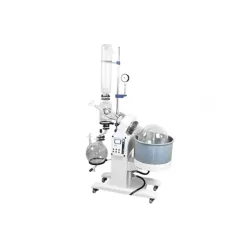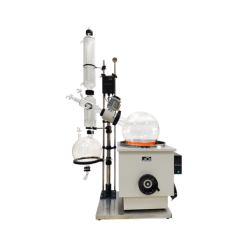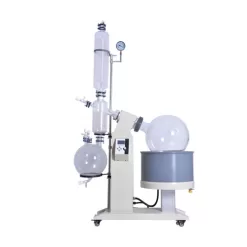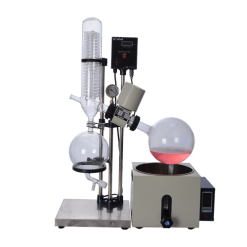A rotary evaporator (rotovap or rotavap) refers to a kind of equipment for solvent evaporation under reduced pressure, which is composed of a vacuum system, a heated water or oil bath, a condenser and a motor that rotates the evaporation flask. As its name suggests, what is special is that the evaporation flask can rotate.
Rotary Evaporators’ Extraction Method
Rotary evaporators extract and concentrate substances from mixtures by heating and evaporating sample materials according to the different boiling points of substances within mixtures. The basic principle of rotary evaporators is the vacuum distillation of the distillation flask under continuous rotation. Many people still wonder the very specific details of rotary evaporators’ extraction method, which will be introduced next.
The extraction process starts with the water oil bath. Firstly, set up the heating temperature of the water oil bath, which are supposed to be same as the boiling point of the components to be extracted. Because the boiling points will be reduced with the decreasing pressure, the components’s boiling points will lower than that under the normal pressure. After the components to be extracted get evaporated successfully, it will be transferred into the condenser where gas-phase substance will be cooled down and becomes liquid-phase. The liquid-phase substance is easier to be collected than the gas-phase substance. Finally, after the gas-phase becomes liquid-phase, the extracted substance will go into the receiving flask, which is easy for users to collect.
Improvement of Rotary Evaporators’ Extraction Method
The rotary evaporator method, liquid-liquid extraction can extract substances efficiently, but it still has some disadvantages. So people use solid phase extraction (SPE), which was used for the formulation of several radiopharmaceuticals for a better use. Due to its high efficiency, reliability, and low consumption of reagents, it has replaced the traditional liquid-liquid extraction in many fields and has become an effective means for sample preparation.
What are the Advantages of Rotary Evaporator?
It has the advantages of small structure, efficient, easy to observe and no metal ion pollution. It is applicable for laboratory, production and valuable material extraction. Its leakproofness ability can compare favorably with foreign equipment while it has improvement in appearance and humanization design.
How We Can Use the Rotary Evaporator for Extraction?
A rotary evaporator is an essential equipment for extraction. Under low temperature and negative pressure, the evaporation flask is rotated by a motor in a thermostat water bath, which makes liquid form a thin film across the interior of the flask so as to increase the evaporation area. It can rapidly extract excess solvent from less volatile samples.
How much vacuum is needed for rotary evaporator?
When using a rotary evaporator, a vacuum is essential in order to reduce the pressure of the system, allowing the solvent to evaporate at a
What are Components of Rotary Tablet Press and Their Functions?
As a kind of mechanical device, the rotary tablet press mainly rotates to compress powder or granules into tablets of uniform size, shape and weight.
What is the Primary Advantage of a Rotary Evaporator over Distillation?
Rotary evaporators are common laboratory equipment mainly composed of a motor, a rotating flask, a water or oil bath and a condenser tube and other
What are Applications of a Rotary Evaporator?
What is a Rotary Evaporator? A rotary evaporator is an indispensable equipment for the processes of evaporation, concentration, crystallization, drying, separation, and solvent recovery in
Rotary Evaporator VS. Short Path Distillation
Similarities and Differences between them Both the rotary evaporator and the short path distillation are the equipment to extract or concentrate substances from mixtures, and both
Failures and Troubleshooting of a Rotary Evaporator
A rotary evaporator is an indispensable equipment for evaporation, concentration, crystallization, drying, separation, and solvent recovery in many fields, and it is mainly used for




